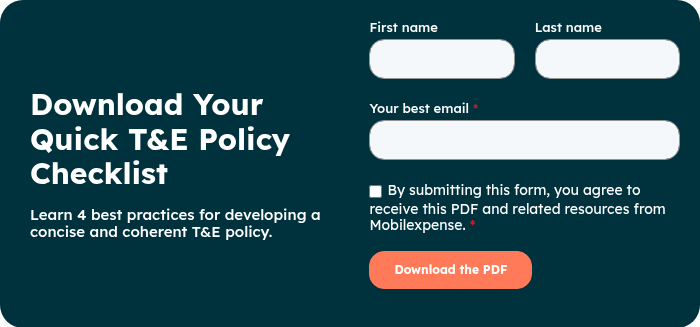Mid-Year Questions To Keep Business Spend Managed
As July arrives, CFOs find themselves at a strategic crossroads.
The perfect halfway point to take stock of the company’s financial performance and course-correct before year-end. While revenue, forecasting, and capital allocation dominate the agenda, there’s a frequently overlooked area that quietly drains time, money and morale - Business spend and expense management.
While travel expenses were once a common source of uncontrolled spending, today, many inefficiencies lie in day-to-day expense handling, policy compliance, and manual processes. These issues, if left unaddressed, can quietly hinder profitability.
Five questions every CFO should be asking this July
As you plan for the second half of the year, here are five key questions to help you assess and improve your current expense management practices.
1. Is your expense policy clear, and consistently followed?
An expense policy is only effective if actively understood and used. However, sometimes employees either don't know what’s allowed or choose to bypass procedures altogether. That creates compliance gaps, unnecessary costs, and friction between finance and other departments.
Mid-year is a great time to revisit your expense policy:
- Is it easy to access and understand?
- Does it reflect how your teams work today (remote, hybrid, cross-border)?
- Have spending behaviours changed post-Q2?
- Are you enforcing it through automation, or still relying on manual policing?
If your policy isn’t embedded into the tools your teams use daily, chances are, it's being ignored. Don't have an expense policy yet? - Read this guide.

2. How much time is your team spending on expense reports?
The average employee spends 15–30 minutes submitting an expense report.
Approvers and finance teams spend just as long reviewing and processing it. Multiply that by dozens or hundreds of reports per month, and it adds up to thousands of hours lost annually on non-strategic tasks.
By automating expense management:
- You eliminate tedious data entry.
- Receipts are scanned and matched instantly.
- Errors and delays are reduced.
- Your team gets time back for value-driving tasks, like spend analysis, vendor management, and cash flow optimisation.
In short, automation doesn’t replace people, it frees them to work smarter.
3. Are you leveraging expense data to drive smarter decisions?
Expense data holds insights into operational health, compliance, and even employee satisfaction, if you know where to look.
With the right solution, you can:
- Identify spending trends by team, category, or location.
- Uncover policy violations or outliers before they escalate.
- Spot duplicate or unjustified claims.
- Benchmark departments and negotiate better deals with suppliers.
Too many CFOs wait for month-end or quarterly reports to act.
4. Are your systems integrated, or still siloed?
Even the best expense tool loses value if isolated from the rest of your financial stack.
Ask yourself:
- Does your expense system talk to your ERP or HR solution?
- Can you reconcile expense data automatically with accounting or payroll?
- Are you able to feed real-time reports to senior management?
Disjointed systems create double work, slow down approvals, and increase the risk of errors. By connecting your expense platform with your ERP, HR, or procurement tools, you make financial accuracy easier.
5. How painful is month-end (and year-end) closing?
Month-end and year-end closings are demanding periods for any finance team. Chasing receipts, validating expenses, and reconciling budgets manually only adds fuel to the fire. If July’s close still required last-minute scrambling, it’s time to fix it before Q4.
Automated expense management means:
- Receipts and approvals are captured in real time.
- All records are audit-ready and searchable.
- Finance teams can close faster, with fewer surprises.
Think of it as future-proofing your Finance function: one automation at a time.
Final thought: small changes, enormous impact
July is more than just a checkpoint, it's a strategic opportunity. By asking the right questions about your expense processes now, you set the stage for a smoother, smarter and more cost-efficient Q4.
A well-integrated, automated expense system not only saves money. It also:
- Enhances compliance,
- Boosts employee satisfaction,
- Provides critical insights for better decision-making.
Use these five questions as a framework to review your policies, processes, and tools. Not just to fix what’s broken, but to build a more resilient, efficient finance function.
Now is the moment to take a closer look at your expense strategy (not just to manage costs), but to lead with greater clarity, control, and impact.

On this page:
Five questions every CFO should be asking
1. Is your expense policy clear, and consistently followed?
2. How much time is your team spending on expense reports?
3. Are you leveraging expense data to drive smarter decisions?
4. Are your systems integrated, or still soiled?
Share this
You may also enjoy
these related stories
/Listing%20Images/Higher%20Tax-Free%20Mileage%20Allowance%20From%202023%20in%20the%20Netherlands%20%E2%80%93%201.png)
Best Expense Management Solutions for the Netherlands
.png)
Best Expense Management Solution for the United Kingdom
/Listing%20Images/Internationale%20Rechnung%20erstellen%20listing.png)
Expense Management Trends for 2026: The Rise of Automation and AI in Expenses
/Listing%20Images/Updated%20VAT%2c%20Mileage%20and%20Allowance%20Rates%20for%202024%20%E2%80%93%201.png)

